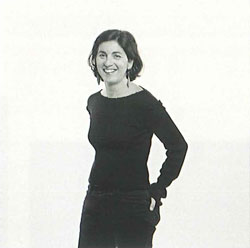Ângela Ferreira
Ângela Ferreira Moçambique ¶ 1958
 |
|
| Créditos fotográficos / Photographic credits: Abílio Leitão |
Having both the South African and Portuguese nationality, she has been living in and out of the two countries. She finished her studies in 1985 at the Michaelis School of Fine Arts of the University of Cape Town, and the following years were spent in Lisbon, where she made a clear and quick ascent in the artistic milieu. ¶ Strangely enough, Portugal is a country without an operative memory of the most recent past, especially where its colonial past is concerned. Ferreira is the first artist to focus on this issue and make it her central theme. She is also the one who, within the national circle, inaugurated a new artistic problematic. Identity, understood as something closely linked to culture, gender, ethnic groupings, and sexual orientation, is the primary focal point of the artistic debates of the 90s. ¶ Due to her double cultural background, European and African, Ferreira attempts to reach that particular point of view that emerges as a non-point of view and constitutes a proposal for an ongoing dialogue. The artist deconstructs her own minimalist references by the sheer evocative power of memory. ¶ Between 1996 and 97, Ferreira engaged upon an illustrative project: at the Chinati Foundation in Texas, which was founded by Donald Judd whose work it holds, she created an installation that takes us back to the popular South-African woman artist Helen Martins. And in Nieu Bethesda, the locale where Martins lived, she used objects reminiscent of Judd's work. This double installation was titled Double Sided, and Ângela Ferreira reached a dialectic of contexts that can be understood as testimony to the geographical and cultural transience of existence. In Amnésia (Amnesia, 1997), she recreated a typical colonial scenery, a living room with all the period's furniture: the spectator could sit down in this space and watch a sentimental video on Portugal's colonial past. In the room next door, three African tree trunks were left lying on the floor. ¶ This ambivalence towards the colonial memory is experienced in the way she deals both with "official" history and that of her own associated, personal memories. By organizing, juxtaposing, and confronting objects, memories and architectures, Ângela Ferreira engages upon an inquiring strategy that operates formally at a level of artistic paradigms, on the one hand, via a permanent questioning of modernist structures, and conceptually at a civilisational level, on the other, via a permanent questioning of cultural determinisms. She was selected for the Portuguese chapter at the Venice Biennial 2007.
http://cvc.instituto-camoes.pt/biografias-en/angela-ferreira-20147.html#sigFreeId195f56d914


